After 15 years of hunting in some of the harshest conditions, I’ve learned one thing: your choice of boots can make or break your hunt. When you’re trekking through wet, cold, and muddy terrain, the right insulated rubber boots are essential to keeping you warm, dry, and focused.

With rubber hunting boots, you get not only waterproof protection but also the insulation needed to withstand freezing temperatures. Did you know that the average hunter walks about 6 miles a day? Without proper boots, those miles feel much longer. In this article, I’ll share the top insulated rubber hunting boots, that I’ve tried and tested, ensuring you stay comfortable in the field, no matter the weather.
List of The Best Rubber Hunting Boots
1. ArcticShield Neoprene Heavy Duty Rubber Boots
Our Pick
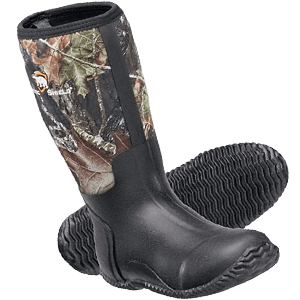
⚙ Main Specifications
- Material: Rubber & neoprene
- Waterproof: Yes
- Insulation: Heat-resistant Arctic Shield Retain insulation
- Neoprene: 7mm
- Warranty: No Information
2. TIDEWE Rubber Neoprene Outdoor Boots
Great Boots
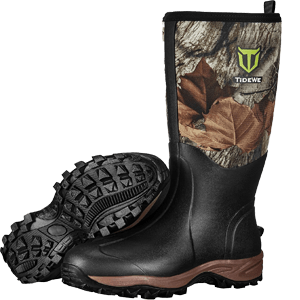
⚙ Main Specifications
- Material: CR Flex-Foam rubber
- Waterproof: Yes
- Insulation: 6mm neoprene
- Neoprene: 4-way stretch nylon
- Warranty: 1 Year
3. BOGS Men’s Classic High Rubber Boots
Lightweight

⚙ Main Specifications
- Material: Hand-lasted rubber over a four-way stretch inner bootie
- Waterproof: Yes
- Insulation: 7mm Neo-Tech waterproof insulation
- Neoprene: Yes, the inner bootie is made of neoprene
- Warranty: One-year
4. HISEA Waterproof Durable Insulated Rubber Neoprene Outdoor Hunting Boots
Cheapest One
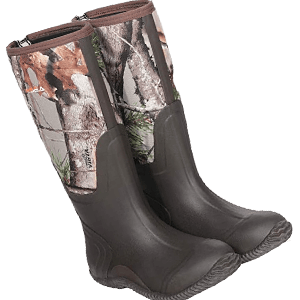
⚙ Main Specifications
- Material: Rubber & neoprene
- Waterproof: Yes
- Insulation: 5mm neoprene insulation
- Neoprene: Provides flexibility and shock absorption
- Warranty: 1 Year
5. Muck Wetland Rubber Premium Men’s Field Boots
Best Overall
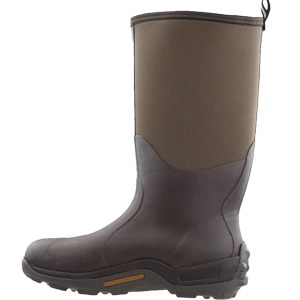
⚙ Main Specifications
- Material: Rubber & neoprene
- Waterproof: Yes
- Insulation: 5mm neoprene bootie
- Neoprene: Airmesh lining
- Warranty: 2 Years
6. LaCrosse Alphaburly Pro 18″ Insulated Hunting Boots
Premium Quality
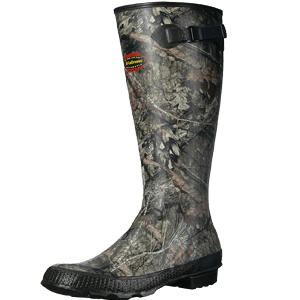
⚙ Main Specifications
- Material: Hand-laid premium ZXT Rubber
- Waterproof: Yes
- Insulation: Non-insulated for all-weather wear
- Neoprene: Neoprene gusset for a comfortable, snug fit
- Warranty: Limited Lifetime
7. TIDEWE 800g Insulation with 7mm Neoprene Sturdy Rubber Hunting Boots
Warmest Boots

⚙ Main Specifications
- Material: Rubber & neoprene
- Waterproof: Yes
- Insulation: 800g
- Neoprene: 7mm
- Warranty: 1 Year
What Are Rubber Hunting Boots and Why Do Hunters Need Them?
Rubber hunting boots are specially designed footwear made from durable, waterproof rubber material that protects hunters from wet, muddy, and harsh outdoor conditions. Unlike traditional boots made from leather or synthetic materials, rubber boots provide 100% waterproofing, ensuring your feet stay dry no matter how deep the water or how wet the terrain.
Why Hunters Need Rubber Boots the Most
1. Waterproof Protection
The most significant advantage of rubber hunting boots is their ability to keep your feet completely dry. In hunting environments, especially in marshes, wetlands, or rainy conditions, water is unavoidable. Wet feet can lead to blisters, discomfort, and even hypothermia in cold conditions. Rubber boots act as a barrier, keeping moisture out and ensuring that your focus stays on the hunt.
2. Scent Control
Deer, particularly whitetails, are known to have an extraordinary sense of smell with over 290 million olfactory receptors, allowing them to detect human scent from great distances. Rubber hunting boots provide an added advantage because they are naturally more scent-proof than leather or fabric boots. They prevent human odor from seeping through, which can help you avoid detection by deer and other game. This makes them an essential tool for any serious hunter.
3. Insulation for Cold Weather
Many rubber hunting boots come with added insulation, essential for hunters enduring cold, frosty mornings or late-season hunts. The insulation traps heat, keeping your feet warm even when temperatures plummet. For example, boots with 800-1200 grams of Thinsulate™ are perfect for extreme cold conditions, ensuring your feet stay comfortable throughout the day.
4. Durability and Traction
Rubber boots are built to withstand tough environments. Whether you’re hiking through rocky paths, deep mud, or snow, rubber boots offer excellent durability and support. Many models feature aggressive tread patterns designed for enhanced grip, preventing slips on slick surfaces and offering stability on uneven terrain.
5. Protection Against Natural Hazards
Hunters often encounter thick brush, thorns, and even snakes while in the wild. Rubber hunting boots offer a protective shield against sharp objects and snake bites. Some boots are even designed specifically to be snake-proof, providing added safety in areas where venomous snakes are a concern.
Did You Know?
Rubber boots have become increasingly popular among hunters due to the rise of wetland hunting and waterfowl hunting, where staying dry is critical. According to a survey, nearly 45% of hunters use rubber boots during the hunting season, a testament to their effectiveness in wet and unpredictable environments.
Things to Consider While Buying Rubber Hunting Boots
When selecting the best rubber hunting boots, it’s essential to keep several factors in mind to ensure you’re getting the right pair for your specific hunting needs. Here are the key elements to consider, with detailed explanations and supporting facts:
1. Waterproofing
While rubber boots are naturally waterproof, not all are made equal. Some boots come with seams or other elements that might compromise the waterproof barrier. Look for boots that offer 100% waterproof construction without weak points.
Fact: Water can quickly cause foot problems such as blisters and fungal infections. Studies show that prolonged exposure to wet environments can lower body temperature, increasing the risk of hypothermia, especially during long hunts in cold conditions.
2. Insulation
The amount of insulation needed depends on the temperature and weather conditions in which you’ll be hunting. Insulated rubber boots use materials like Thinsulate™ or neoprene to trap body heat, keeping your feet warm.
- Light Insulation (200-400 grams): Ideal for warmer weather or high-activity hunts.
- Moderate Insulation (600-800 grams): Suitable for mild to cold weather conditions.
- Heavy Insulation (1000-1600 grams): Best for extreme cold, such as late-season or winter hunts.
Fact: Feet are highly sensitive to cold because they have a large surface area but very little muscle, which generates less heat. Proper insulation can prevent frostbite and improve overall hunting endurance in cold weather.
3. Comfort and Fit
The fit of rubber boots is crucial for comfort, especially when hunting involves a lot of walking. Boots that are too tight can restrict blood flow and cause discomfort, while boots that are too loose can lead to blisters. Consider getting boots with a roomy toe box and adjustable straps to ensure a secure fit.
Fact: The average hunter walks 6-8 miles per day during a hunt. Wearing boots that don’t fit well can increase the risk of foot fatigue, blisters, and injuries, reducing hunting efficiency.
4. Traction and Outsole Grip
Rubber boots come with various types of outsoles, each designed to provide traction on different terrains, from muddy fields to rocky hillsides. Aggressive tread patterns can offer better grip, reducing the chance of slipping on wet or uneven ground.
Fact: Slips and falls are one of the most common causes of hunting accidents. According to the National Safety Council, outdoor falls account for 21% of all hunting-related injuries. A boot with strong traction is essential for preventing these types of accidents.
5. Socks: The Essential Partner for Your Boots
Even the best boots won’t keep your feet warm if you’re wearing the wrong socks. Cheap cotton socks trap moisture, leading to cold feet and blisters, especially in wet conditions. Instead, invest in high-quality hunting socks made from wool or moisture-wicking materials. Many boot brands recommend specific socks, so when buying new boots, it’s worth spending a little extra on a good pair to stay warm and dry.
Fact: Wool can absorb up to 30% of its weight in water without feeling wet, making it ideal for hunting socks.
6. Scent Control
As mentioned earlier, deer have an extraordinary sense of smell. Some rubber boots are treated with scent control technology to help minimize human odor and prevent detection by game. The rubber material itself already limits scent leakage compared to leather or fabric boots.
Fact: Whitetail deer can detect human scent from up to half a mile away, making scent control one of the most important factors for hunters who rely on stealth to get close to their prey.
7. Height and Coverage
Rubber boots come in different heights, typically ranging from ankle to knee-length. The height you choose should depend on the type of terrain you’ll encounter and the level of protection you need. Higher boots are ideal for marshy, wetland hunting, while lower boots may suffice for drier, less dense terrain.
- Ankle-high: Best for dry, mild terrain with minimal water exposure.
- Mid-calf: Good for occasional wet areas, providing moderate protection.
- Knee-high: Offers full protection in marshes, streams, or deep snow.
Fact: Taller boots provide better protection against water, debris, and even snake bites, which can be crucial for hunters in regions with venomous snakes.
8. Durability and Material Quality
Rubber hunting boots are designed to be tough, but some materials last longer than others. Boots made from thick, high-quality rubber are more durable and better suited for rugged conditions. Look for boots that are reinforced in areas that receive the most wear and tear, such as the toes and heels.
Fact: Cheap, low-quality rubber boots may crack or degrade quickly, especially after prolonged exposure to sunlight and harsh environmental conditions. Investing in a quality pair can save money in the long run, as they last several hunting seasons.
9. Weight
Weight is another important factor, especially if you’ll be covering long distances or hiking through difficult terrain. While rubber boots tend to be heavier than other types of hunting footwear, lightweight models are available that offer waterproof protection without weighing you down.
Fact: Heavier boots can lead to increased energy expenditure and foot fatigue. A study shows that for every 1 pound added to the weight of a shoe or boot, energy expenditure increases by approximately 5%. Lighter boots can improve your mobility and endurance during long hunts.
10. Temperature Rating
Always check the temperature rating of insulated rubber boots to ensure they are appropriate for the conditions you’ll be hunting in. Manufacturers often list temperature ratings, indicating the coldest conditions the boots are designed to handle.
Fact: Feet can lose heat faster than other parts of the body, especially in freezing conditions. Wearing boots with the correct temperature rating helps avoid frostbite and keeps you hunting longer in the cold.
11. Price and Warranty
Rubber hunting boots come in a wide range of prices depending on the brand, materials, and features. While it’s tempting to go for a cheaper option, investing in a high-quality pair will often pay off in the long run. Check if the boots come with a warranty, as this can be a good indicator of their durability.
Fact: The average hunter spends around $150 on rubber hunting boots, but premium models can cost up to $300 or more. However, these higher-end models often last longer and provide better protection, saving money in replacement costs over time.
Final Thoughts
Investing in the right rubber hunting boots is crucial for any hunter, offering waterproof protection, insulation, and durability to tackle tough environments. However, don’t overlook the importance of pairing them with high-quality socks and ensuring a proper fit. By considering factors like insulation, traction, scent control, and comfort, you can enhance your hunting experience and stay focused, no matter the conditions. With the right boots on your feet, you’ll be ready for any challenge the wild throws your way.
Frequently Asked Questions (FAQs)
1. What’s the best insulation level for rubber hunting boots?
The right insulation level depends on the temperature and activity level. For mild weather, 200-400 grams of insulation works well. For colder conditions, 800-1600 grams will keep your feet warm during long, cold hunts.
2. Do rubber hunting boots provide good scent control?
Yes, rubber is naturally better at containing human scent compared to fabric or leather boots, making it a great choice for hunters who need to avoid detection by game like deer.
3. How do I choose the right boot size for hunting?
It’s essential to try on boots with your hunting socks to ensure a snug fit. The boots should offer enough room for your toes to move, but not be too loose to prevent blisters or foot fatigue.
4. Are rubber hunting boots suitable for all terrains?
Rubber hunting boots are ideal for wet, muddy, and marshy environments, but you should consider models with aggressive tread patterns for better traction on rocky or uneven terrain.
Leave a Reply